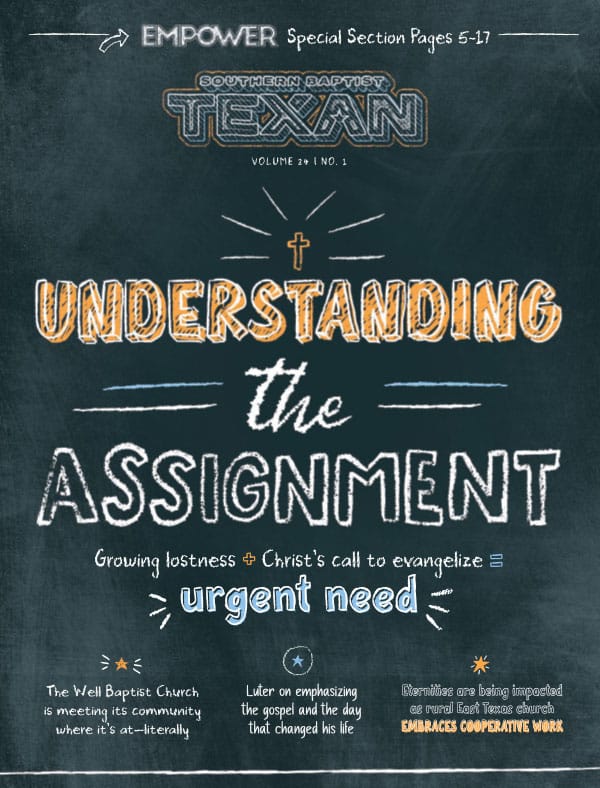LABELLE, Texas—As the sun shone over Houston Wednesday, the remnants of Hurricane Harvey gave Texas one last punch, inundating the Beaumont-Port Arthur region with 26 inches of rain in 24 hours before lurching into Louisiana. Southeast Texas churches that did not take on water took in evacuees in the wake of the storm locals are calling worse than Hurricane Ike.
Not until the rain began to dissipate Wednesday could pastors, church members and Southern Baptists of Texas Convention Field Ministry Strategists (FMS) begin to assess the damage in communities west of Houston and east to the Sabine River. But with hundreds of roads still partially submerged, getting eyes on entire neighborhoods has been impossible. Phone contact, when possible, had to suffice and began to paint an incomplete yet sufficient enough picture of incomparable devastation mingled with God’s immeasurable grace.
Get up-to-date information, find opportunities to volunteer, and give online
“They have measured life by Ike, and now that’s been entirely eclipsed,” said Sonny Hathaway, pastor of LaBelle Baptist Church, 10 miles south of Beaumont. The church began taking in evacuees in the predawn hours of Wednesday as water poured into homes.
Water evacuations had already taken place Tuesday in Jefferson County when the sky opened up that night dumping 18 inches of rain between 9 p.m. and midnight. Hathaway said residents flooded from their homes began arriving at his locked church around 4 a.m. Wednesday. About one-third were church members. By noon about 120 people had taken shelter there.
“This place just became a place of refuge,” Hathaway said.
Hathaway, who has pastored at LaBelle for four years, said 80 percent of the church lost homes during Hurricane Ike 10 years ago. But a constable who lost his home to Harvey said this storm is 10 times worse.
Hathaway said his conversations with state and local emergency management personnel reveal the magnitude of the disaster.
“They look at me like they’re shell-shocked. Like they don’t know what to do,” he said.
Dennis Parish, FMS for the greater Houston area, could not reach his church, Needham Road Baptist Church, to assess damage until Wednesday. The building sustained little damage from the storm but a human intruder had broken into the church office and stolen cash, the church debit card and Parish’s handgun.
While filing a police report, Parish’s thoughts were with the churches in his region.
“I’m trying to contact several churches, and no one is answering. There are neighborhoods I can’t get into,” Parish said. “I have a big truck, and I’m hesitant to go [certain places].”
Bill Collier, FMS for the region east and northeast of Houston, is in the same predicament. Of the churches he has been able to contact, four took on water. FBC Fannett had taken in evacuees before taking on water forcing everyone to the second floor, Collier said.
In total 764 SBTC churches—more than one-fourth of the total churches in the convention—are in the 54 counties hit by Hurricane Harvey.
But help is on the way.
“We see a great demand of churches who want to be involved,” Mickey Caison, North American Mission Board Southern Baptist SEND Relief executive director, told the TEXAN Wednesday evening as he drove toward Houston from Georgia.
Caison said NAMB is assessing how best to utilize the limited volunteer and financial resources for what is, admittedly, an overwhelming situation. Even if all Southern Baptists showed up, there would still be work to do he said.
NAMB disaster relief strategists, including David Melber, NAMB vice president of SEND Relief, will coordinate with leadership at Houston’s First Baptist Church, using the church’s four campuses as staging areas for DR team deployments. The campuses are providentially located in some of the regions hardest hit by Harvey’s rainfall.
Caison said the NAMB leadership will “stay out of the way of the Green Berets of Southern Baptists”—the yellow-shirted disaster relief teams. More volunteers will be forthcoming, and NAMB will coordinate those deployments.
NAMB leaders hope to facilitate a culture of “churches helping churches,” Caison said. Texas congregations ministering within the disaster area will need encouraging too. The long-term work of hurricane disaster relief can carry on most effectively when churches from outside the disaster area partner with those toiling within to meet their needs so they can continue to minister to the community.
An example of how that might work played out Wednesday and into Thursday morning in Madisonville, 40 miles northeast of Bryan-College Station, where Kevin McKenzie, owner of McKenzie’s Barbeque and Burgers, packed enough food in his truck Wednesday to feed 200-300. The destination? First Baptist Church in Port Neches 176 miles away where at least 200 people had sought refuge from rising waters but had few provisions.
McKenzie became aware of their plight Wednesday morning as he and other local restaurant owners and area church representatives met at First Baptist Church Madisonville to discuss how to assist hurricane evacuees making their way to their small town of 4,396. As they met someone called the church alerting them to the plight in Port Neches.
In less than an hour McKenzie had cold cuts, chicken salad, chips, bread, buns, apples, bananas and protein drinks loaded in his truck. He headed to Trinity Pines Baptist Church over an hour away where he met Pastor Jonathan Davidson and church member Tom Foucha who took the food the final, water-logged, leg of the trip.
Davidson told the TEXAN he and Foucha drove through 12-18 inches of water in places to reach the church. By the time they arrived, the number of evacuees had swelled to 400 with some taking shelter in the junior high across the street.
Everyone received dinner, but breakfast was served with some bitter news—city officials had determined the church could no longer serve as a shelter.
“When we told them they had to pack up and leave, it was hard,” Davidson said.
Busses ferried evacuees to a local airport where they loaded Chinook helicopters headed for Galveston. From there they would board buses for a shelter in Dallas.
Davidson and Foucha, both former Marines, stayed behind this morning, joining forces with the Coast Guard personnel as they searched the as yet unreached area of Groves, Texas.
In LaBelle, Hathaway said as a pastor his role is to dispel the tension that wells up with the water and threatens to overwhelm those trying to help, many of whom have losses of their own.
“They are tired, exhausted and concerned about their families,” he said of his church volunteers caring for evacuees. “They have been on the phone with family who are evacuating while trying to serve lunch.”
By God’s grace the church will be the one thing a community should be able to depend on Hathaway said.
Get up-to-date information, find opportunities to volunteer, and give online at sbtexas.com/harvey.












